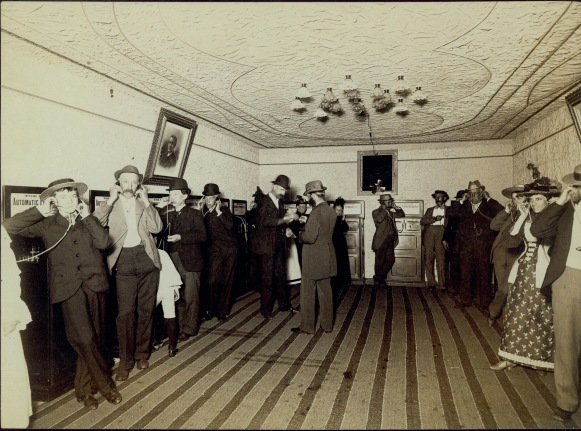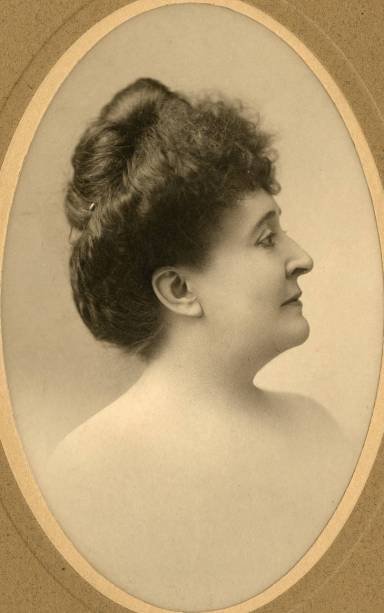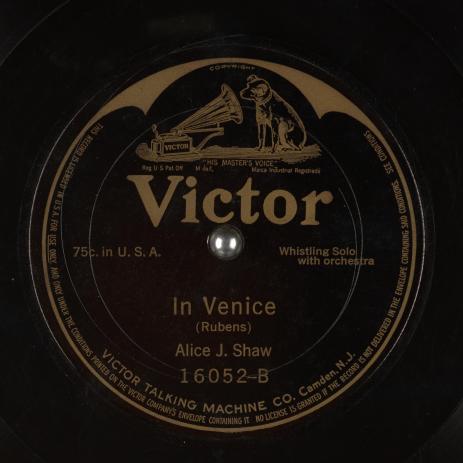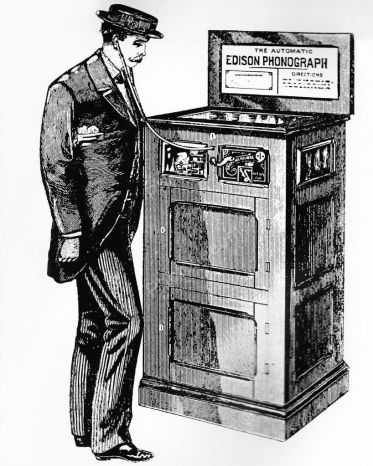
Phonograph parlor, mid-1890s.
Prior to 1895, the average person was only likely to come into contact with a phonograph at a demonstration presented by an exhibitor or at a phonograph parlor, an establishment that offered coin-operated machines at which customers could listen to records through tubes resembling a stethoscope. For the most part during this early period, it was only the wealthy—or at least the very comfortable—who actually owned machines in their homes. This means that the vast majority of records produced in these earliest days were sold not to individuals, but to these parlors and exhibitors. Local newspapers from the era are excellent sources of information on early phonograph culture. They would often mention the most popular selections that an individual parlor or exhibitor was featuring during a given week. These advertisements were not trying to sell phonograph records to the public, but to lure customers in to pay a fee to hear the recordings. To be clear, we’re primarily talking about cylinders here, the flat disc being still in its infancy. These announcements of local phonographic events often contain surprising details and can be extremely useful to the discographer of early material, but they can also create just as many puzzles as they solve.
On June 16, 1889, The Boston Globe reported that an Edison phonograph could be heard—“experienced” might be a more apt word at this early date—at the recreation of the Battle of Gettysburg that was currently drawing crowds in the city. Visitors to the exhibit could hear the voice of the English actress Ellen Terry, or Marie Jansen’s rendition of the slightly risqué “Be Good” from the comic opera The Oolah, which was still running on Broadway that summer. The third recording highlighted by the article was a rendition of an aria from Verdi’s Il Trovatore by a “lady whistler” named Alice J. Shaw. The tone of this announcement implied that all three women were more or less household names to Bostonians. As obscure as they now may seem, the careers of both Terry and Jansen are well documented in works on theatrical history. But history has not treated Alice J. Shaw as well. Despite her widespread fame and success, her story seems to have faded into the archive, treated as just another late 19th-century novelty act.
What is known about Mrs. Alice J. Shaw comes mostly from publicity material and newspaper accounts. She was born Alice Horton about 1855 in Elmira, New York. Her father was a businessman, and evidence suggests the family was seen as cultured as well as financially comfortable. She married W. W. Shaw in 1873, and soon thereafter the couple moved to Detroit, where their first two daughters were born. After Mr. Shaw’s business failed, the family relocated to New York City in search of financial salvation. This was not to be found there, however, so Alice was forced to make “a bitter struggle to maintain the family by dressmaking.” In the meantime, she gave birth to a set of twin daughters. Unable to make a living in the city, the family of six moved back to Elmira to live with Alice’s parents. Some time in 1885, Mr. Shaw left the family in Elmira and headed to parts unknown in search of opportunity. It was shortly after this that Alice Shaw came up with an unlikely way to support herself and her four daughters: she would become a professional whistler.

Mrs. Alice J. Shaw, 1905.
At the time, her choice was not as unlikely as it may now seem. Whistlers were relatively common on the stages of theaters that offered “polite variety,” a theatrical form that was just beginning to be called by a new name: vaudeville. Alice reportedly returned to Detroit to try her whistling act on the stage there. Audiences responded so well that she was encouraged to continue with her newfound career. But this is all backstory. Alice Shaw first appears in the record in her musical role in New York City in May 1886, whistling the light classics at society charity functions. By all accounts, although her act was most decidedly received as a novelty, she was charming, cultured, talented, tasteful in her selections, and could sight read. Audience members often entered her performances as skeptics, but left as converts.
In 1888, she traveled to London, armed with introductions provided by Mrs. Vanderbilt. These were sufficient to gain her entrée into the drawing rooms of the aristocracy, which eventually landed her at the dinner table of the Prince of Wales, the future Edward VII. She charmed the prince, and later played up this royal connection when touring American theaters. There, to evoke a touch of Continental flair, she was often billed as La Belle Siffleuse. Eventually adding her youngest two daughters to the act, she toured extensively, not only on the US vaudeville circuit, but worldwide. During her career she performed, either solo or with her daughters, in Great Britain, Germany, Russia, and India, and she even began a tour of South Africa that was cut short by the outbreak of the Boer War.
Audiences love a bit of scandal attached to their celebrities and Shaw’s story, though not exactly scandalous, was not without its spice. When the press talked about her at length, a standard part of the story was that she was forced into the entertainment field to support her four daughters. The exact circumstances were discreetly rarely mentioned. However, in late 1888, newspapers reported that she had obtained a divorce from W. W. Shaw, her husband of fifteen years. Most articles of the period only hinted that Alice was an abandoned woman, that Mr. Shaw had shirked his responsibility and left her and their four children to fend for themselves. When her divorced status was mentioned it was done as a statement of fact; there was no noticeable whiff of censure for her part in the situation. After the divorce, however, newspapers did from time to time exhibit an interest in her love life. In the 1890s, there were various reports that she had turned down offers of marriage from British and European nobility. One report even claimed that the Shah of Persia had offered to buy her and take her back to his country. Most bizarrely though, in October 1888, just after her divorce was announced and as her fame was just beginning to grow, there were short-lived reports in both the American and British press that she was engaged to be married to Buffalo Bill Cody. This rumor vanished as quickly as it appeared.
In 1889, Alice J. Shaw’s act reportedly earned her $25,000, a huge sum at the time. But by 1903, she and her three youngest daughters were living with an aunt in upper Manhattan. Although she was still performing in theaters, by this point she was living paycheck to paycheck. In 1907, already a fading star, she made her only confirmed commercial recordings. She died on April 22, 1918, at her home in Brooklyn. After a funeral in New York City, her body was brought back to her hometown of Elmira, New York, for burial. Although the Elmira Star-Gazette carried a prominent article about her—albeit on page 10—The New York Times announcement of her death was much more succinct: “At her residence…Alice J. Shaw. Funeral private. Omit flowers.”
The announcement by The Boston Globe in 1889 that an exhibitor in that city possessed a recording by Alice Shaw presents something of a discographical problem. Although evidence suggests that she recorded at least three times in the 19th century, the only documented commercial recordings by Shaw date from 1907, these being two Victor discs and an Edison cylinder on which Shaw—accompanied by her twin daughters and a backing band—whistles a tune called “Spring-Tide Revels.” There is no direct evidence, physical or otherwise, that a commercial recording bearing her name was released before this time. So what are we to make of this?

Although it occurred in a private home, Alice Shaw’s first encounter with the recording horn is actually well documented. On August 14, 1888, Colonel George Gouraud, a colorful American Civil War veteran and Thomas Edison’s agent in England, held a press conference at Little Menlo, his house in London. The intention was to inform the British public that the Edison phonograph had arrived on its shores. Afterwards, he held a number of well-publicized parties at his home at which notable personalities were encouraged to perform for, or send greetings to, Thomas Edison by way of recorded cylinder. Wooden crates of these “white wax” cylinders were then sent back to Edison in New Jersey. Mrs. Shaw was present at the first of these parties and recorded one of her whistling specialties. Luckily, the crate containing this recording still survives at the Edison National Historic Site, and its contents were transferred to tape by the New York Public Library in 1995.
The Globe article in June 1889 reported that Alice recorded her rendition of the Verdi aria “just before she sailed for Europe.” This apparently refers to her return to London the previous month. This date is tantalizingly close to that of the first known batches of cylinders sold by the North American Phonograph Company to its licensees. In late May 1889, the company advertised “Musical phonograms [cylinders] in boxes of 6 and 12 (assorted)” at 45 cents each wholesale. When the company finally issued a list of available titles the following January, however, Mrs. Shaw’s name did not appear. But this is only the first mystery recording by Mrs. Shaw.
The November 1892 issue of The Phonogram, reported that Alice Shaw had recently “whistled into a phonograph cylinder.” The article added that it was “the intention of Mrs. Shaw to practice into the phonograph and thus preserve the permanent traces of effects which would otherwise be wasted. These will be preserved in ‘phonograph cabinets,’ and may be brought out and rendered audible at pleasure by every possessor of the instrument.” The evidence of an 1892 recording by Shaw is strengthened by the fact that a number of phonograph parlors and exhibitors in Utah, Nevada, California, Washington, and Texas between 1892 and 1897 mentioned having a recording by her in their advertisements. It is interesting that all of these examples are clustered in the western states, and that except for a single example from Seattle in 1897, all date from October 1892 to January 1894, a span just a bit over one year. This also nests conveniently well with the date of The Phonogram article mentioned above. A cynic might say that it would be very easy for an exhibitor to take any recording of a whistling solo and claim that it was by the renowned Mrs. Shaw in order to draw customers. This may be true, but the relatively tight geographical and chronological cluster lends strength to the theory that a commercial recording that we have simply not identified must have been released.

Using the traditional approach, a discography of Alice J. Shaw’s recordings would include only the 1907 Edison cylinder and the Victor discs. Depending on scope, it might also include the 1888 “white wax” cylinder recorded in London. But such a discography would be a very long way from fulfilling its primary purpose: showing the complete picture of the complexities of the recording history of its subject. Many aspects of phonograph culture in the 19th century are unique to the era. Examples of “lost” recordings such as those of Mrs. Shaw abound throughout the period. They are “lost” first and foremost because neither physical examples nor documentary evidence of their existence have been located. Information about many of them only exists as fragments of evidence scattered throughout the archive, not as data conveniently held in company records or on the recordings themselves, as is the case with later material. Nineteenth-century discography is already an area that relies as heavily on the archival as it does on the physical. Because of the scarcity of physical examples and very sparse documentation that survives, we will likely never have a truly complete picture of the recording history of the phonograph’s earliest days. I hope to go into this in greater detail in a future post, but if something approaching a comprehensive discography of these earliest recordings is ever to be achieved, it will require a much deeper immersion into the archive as well as a new form of presentation. I have begun to refer to this as reconstructed discography, one in which the actual and the theoretical are both allowed into the main narrative.
The case of Alice J. Shaw and her lost recordings is simply one example that highlights how much discographical research is still needed into the days of the nickel-slot phonograph. Much of the excellent research that has emerged in this area over the years has been the work of avid collectors and fans, not professional scholars. As the original material becomes even more rare and harder to find in the marketplace, fewer collectors are likely to be drawn into the field. New researchers will therefore need to find the subject by other routes. At first glance, the history of the phonograph’s beginnings seems like a tale of lawsuit heaped upon lawsuit, only of interest to a patent attorney. There is a large amount of truth in this. But I think Mrs. Shaw’s case shows that there are still a great number of human stories lurking just beneath the tangled narrative of inventions, lawsuits, and countersuits, stories that simply need to be plucked from the archive and told.
—Stephen Canner
Resources
Mrs. Shaw’s 1888 London Recording
Mrs. Alice Shaw and Her Twin Daughters – “Spring-Tide Revels”

As ever, very nicely done. Looking forward to more reconstructed discographies.
LikeLike
Great post! I’d love to use the lead photograph in a case I’m writing, but want to make sure I’m ok on the copyright. I know that the original is beyond the copyright duration, but do you know if anyone has any existing claims on it? Thanks for you help.
LikeLike
Hi Dan, thanks for the note. I’m not certain of the photo’s original source, just that it’s out there across the web in various forms. A quick search of the obvious places like the LOC turns up nothing. One site does credit it to the National Park Service, which to me would imply that it is now completely PD, but I’ve not been able to verify. Hope that helps! —Steve
LikeLike